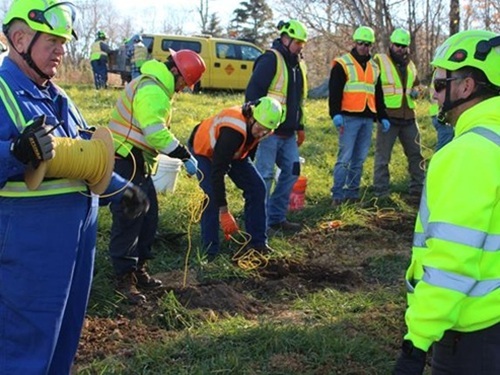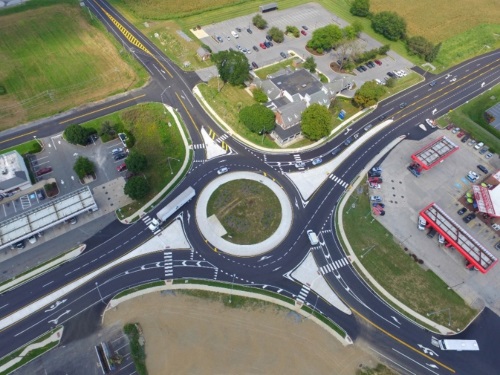The latest data compiled by the Pennsylvania Department of Transportation indicates that motor vehicle fatalities, injuries, and crashes decreased overall after the installation of 36 roundabouts at 33 intersections statewide.
[Above photo by PennDOT]
PennDOT based its analysis on at least three years of crash data from roundabouts on state routes at intersections that were previously stop or signal controlled. The agency said its analysis indicated that roundabouts reduced suspected serious injuries by 76 percent and reduced suspected minor injuries by 22 percent, with the total number of crashes decreasing by 9 percent.
In addition to those 36 roundabouts, PennDOT said it has built 38 additional roundabouts on state routes, with 16 more under construction and 15 in final design.
PennDOT noted that it usually builds roundabouts to address intersections with safety issues, but also constructs them to improve traffic flow as well as other reasons, such as traffic calming and to facilitate pedestrian mobility.
Although roundabouts are safer and typically more efficient than traditional signalized intersections, the agency stressed that they may not always be the best option due to topography or other reasons, such as property impacts, capacity issues, and proximity to other intersections.
The agency added that the Pennsylvania State Transportation Innovation Council or STIC recently recognized roundabouts as an “innovation” that is being commonly used in traffic intersection construction.

“We continue to see that Pennsylvania’s roundabouts save lives and reduce crash severity,” said PennDOT Secretary Yassmin Gramian in a statement.
“While they aren’t the right option in every intersection, we’re pleased that they help to make our roadways safer,” she noted.
In July 2020, the Transportation Research Board unveiled a National Cooperative Highway Program analysis of roundabout intersections that found while improved safety is their main benefit they may also be a less expensive option as well as a way to make better use of space at roadway intersections.
That NCHRP report – entitled Design Guidance for High-Speed to Low-Speed Transitions Zones for Rural Highways – also found that roundabout intersections, particularly those with only one lane in each direction, reduce the complex decisions drivers, pedestrians, and cyclists must make in navigating traffic, leading to fewer crashes and less severity of injuries when crashes do happen.
 States
States
NCDOT Staff Participate in ‘Explosive’ Technical Training
December 19, 2025 States
States

